Utah - 2017 Adoption Materials
View Utah BrochureRequest a SampleUtah Educational Consultant
Select the course title below to view textbook information.
View All
Adult Roles, Integrated FCS, Life Management
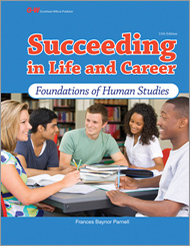
By: Frances Baynor Parnell
Grade Level: 9-12
Succeeding in Life and Career: Foundations of Human Studies, 11th Edition
- Sample Student Login
Website: www.g-wonlinetextbooks.com
Username: succeedingut
Password: utah17
- Students gain hands-on experience building a portfolio by completing chapter projects.
- Special features relate content to financial literacy, math, science, mental health, wellness, healthy living, life skills, and environmental topics.
- Critical thinking and 21st century applications activities at the end of each chapter develop college and career readiness skills.
- Classroom learning and FCCLA participation are encouraged through chapter review activities.
Adult Roles, Life Management

By: Leona Johnson
Grade Level: 9-12
Interpersonal Relationships
- Sample Student Login
Website: www.g-wonlinetextbooks.com
Username: interpersonalut
Password: utah17
- Numerous features invite students to apply chapter concepts to their own lives and to the lives of people all around the world.
- Reading Prep, Focus Your Reading, and Think About Your Reading activities prompt students to engage critically with the text.
- A variety of rich, real-world activities reinforce chapter information and challenge students to analyze and use the information individually and in small groups.
Agricultural Mechanics
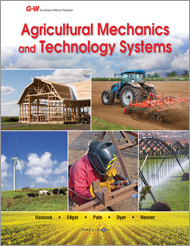
By: J.P. Hancock, Don W. Edgar Ph.D., Michael L. Pate Ph.D., Lori A. Dyer, and W. Brian Hoover Ph.D.
Grade Level: 9-14
Agricultural Mechanics and Technology Systems
- Sample Student Login
Website: www.g-wonlinetextbooks.com
Username: agmechanicsut
Password: utah17
- The chapter Trends and Emerging Technologies introduces students to the many high-tech applications of agriculture and agricultural mechanics, including geographic information systems (GIS), telematics, sustainable energy sources, precision agriculture, wireless sensor networks, and the use of drones.
- A chapter on safety and extensive "Safety Notes" cultivate a safety-first mindset and drive home the point that safe work habits are needed in every domain of agricultural mechanics and technology.
- Reading and writing skills are developed by the careful definition and use of technical terms, by "Before You Read" guidance provided at the start of every chapter, and by "Communicating about Ag Mechanics" exercises at the end of every chapter.
- "Hands-on Agriculture" and "STEM and Academic Activities" provide engaging, inquiry-based learning activities for students and provide a bridge between theory and practice.
- To highlight safe, correct, and current practices, high-quality photographs and line art accompany text descriptions on nearly every page of the text.
Apparel Design & Production I, II
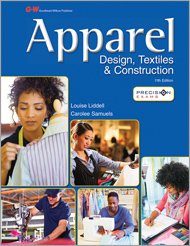
By: Louise A. Liddell and Carolee S. Samuels
Grade Level: 9-12
Apparel: Design, Textiles & Construction, 11th Edition
- Sample Student Login
Website: www.g-wonlinetextbooks.com
Username: apparelut
Password: utah17
- This edition provides multiple new opportunities for the integration of STEM (science, technology, engineering, and math). Updated STEM features and new STEM-related activities challenge students to apply chapter concepts using these relevant skills.
- New and updated content about global trends and technology in the apparel and textile industries gives students the most current information. An updated design with attractive new illustrations invites students to engage more easily with the text.
- In addition to multiple critical thinking, reading, writing, math, technology, science, and speaking activities, new career readiness activities prompt students to apply chapter content to the workplace.
Architectural Design I
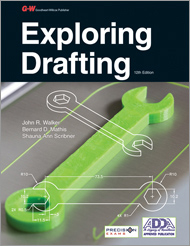
By: John R. Walker, Bernard D. Mathis, and Shauna Ann Scribner
Grade Level: 9-14
Exploring Drafting, 12th Edition
- Sample Student Login
Website: www.g-wonlinetextbooks.com
Username: draftingut
Password: utah17
- Content is appropriate for beginning drafting students at any instructional level.
- The end-of-chapter drawing problems help students build problem-solving skills and practice drafting techniques.
- The text follows ASME practices and serves as an ADDA approved publication.
Cabinetmaking and Millwork

By: William D. Umstattd, Charles W. Davis, and Patrick A. Molzahn
Grade Level: 9-14
Modern Cabinetmaking, 5th Edition
- Sample Student Login
Website: www.g-wonlinetextbooks.com
Username: cabinetmakingut
Password: utah17
- The text and workbook correlate to Woodwork Career Alliance standards, ensuring that students gain the skills they need to be successful in industry.
- Content is organized in a logical sequence, teaching students the design and construction process in a step-by-step manner.
- Three new chapters have been added for this edition—Cabinetmaking Industry Overview, CNC Machinery, and Sharpening—to support student learning of the latest standards, technology, and techniques.
College and Career Awareness
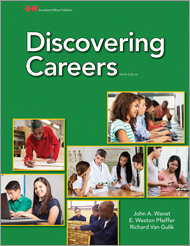
By: John A. Wanat, E. Weston Pfeiffer, and Richard Van Gulik
Grade Level: 6-8
Discovering Careers, 9th Edition
- Sample Student Login
Website: www.g-wonlinetextbooks.com
Username: discovercareersut
Password: utah17
- A project-based Personal Achievement Plan guides students in preparing a career plan.
- College and Career Readiness Portfolio activities provide students an opportunity to create a personal portfolio.
- A Math Skills Handbook provides a quick reference for basic math functions.
Fashion Design Studio

By: Mary G. Wolfe
Grade Level: 9-12
Fashion, 7th Edition
- Sample Student Login
Website: www.g-wonlinetextbooks.com
Username: fashionut
Password: utah17
- Help students understand today’s apparel industry and learn the skills needed to become more attuned to consumer concerns.
- Explore globalization and current trends for textile companies, apparel manufacturers, retailers, and consumers, including industry-wide collaboration, omni-channel retailing, and cross-channel shopping.
- Analyze how the availability of information online is changing fashion firms’ product development, promotion, and selling techniques and how apps and social media affect consumer comparison shopping and buying practices.
- Weigh the dilemma of imports, environmental sustainability, and ethical and social issues about companies when buying their goods.
- Expose students to career clusters and the many career opportunities within the apparel industry.
Food & Nutrition I, II
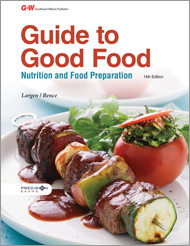
By: Velda L. Largen and Deborah L. Bence
Grade Level: 9-12
Guide to Good Food: Nutrition and Food Preparation, 14th Edition
- Sample Student Login
Website: www.g-wonlinetextbooks.com
Username: guide2foodut
Password: utah17
- Enhanced visuals program employs infographics and images to emphasize content and improve recall.
- The Foods of the World section explores the culture and cuisine of over 30 countries.
- Students can complete and submit review questions digitally, enhancing instructor's assessment of students’ comprehension and reducing paper waste.
Interior Design I, II

By: Dr. Evelyn Lewis and Carolyn Turner Smith, Ph.D.
Grade Level: 9-12
Housing and Interior Design, 11th Edition
- Sample Student Login
Website: www.g-wonlinetextbooks.com
Username: housingut
Password: utah17
The revised Housing and Interior Design text introduces students to foundational principles and skills characteristic to housing and interiors professions. Aimed at high school students and courses, the text addresses both interior and exterior design and introduces students to the phases of the design process. Concepts include the historical, cultural, governmental, and technological factors that influence housing, along with a discussion of various architectural styles, reading floor plans and architectural documents, and space planning. Students learn about the processes, materials and finishes, construction basics, interior systems, and much more. The text also addresses green and sustainable design and universal design throughout.
- Content emphasizes the knowledge and skills students need for housing and interiors careers through the Architecture & Construction and the Arts, A/V Technology & Communications career clusters and pathways.
- The practical aspects of choosing housing, such as security, health, and safety, as well as costs and maintenance engage students with real-world applications.
- Students are encouraged to develop their housing and interior design skills through community service projects and FCCLA activities and competitive events.
- Correlated to FCS National Standards 3.0 for Area 11: Housing and Interior Design, AAFCS Pre-PAC competencies and credentials for Housing and Furnishings and Interior Design Fundamentals, as well as the YouScience® Industry Certifications Interior Design I and Interior Design II industry-recognized credentials.
Does your program incorporate soft skills development for students? Since every occupation needs these foundational skills, consider adding Soft Skills for the Workplace to your order.
Occupational Experiences
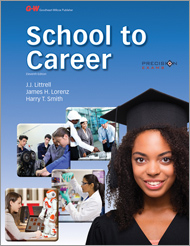
By: J.J. Littrell, Ed.D., James H. Lorenz, Ed.D., and Harry T. Smith, Ed.D.
Grade Level: 9-12
School to Career, 11th Edition
- Sample Student Login
Website: www.g-wonlinetextbooks.com
Username: school2careerut
Password: utah17
- A Lifespan Plan project-based activity opens each unit to guide students in the creation and evaluation of their own short- and long-term career and life goals.
- College and Career Readiness Portfolio activities provide students an opportunity to create personal portfolios for use when exploring volunteer, education and training, or career opportunities.
Small Vehicle Technician
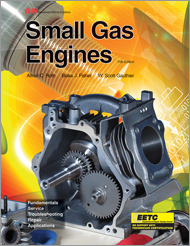
By: Alfred C. Roth, Blake J. Fisher, and W. Scott Gauthier
Grade Level: 9-14
Small Gas Engines, 11th Edition
- Sample Student Login
Website: www.g-wonlinetextbooks.com
Username: sgeut
Password: utah17
- A variety of engine types from a wide range of manufacturers are presented.
- Career content includes information on Equipment & Engine Training Council (EETC) certification.
- The Small Gas Engines Workbook has sample EETC certification tests for Two-Stroke Engines and Four-Stroke Engines.
Welding Technician
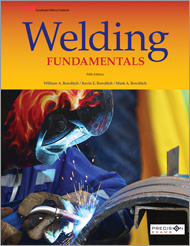
By: William A. Bowditch, Kevin E. Bowditch, and Mark A. Bowditch
Grade Level: 9-14
Welding Fundamentals, 5th Edition
- Sample Student Login
Website: www.g-wonlinetextbooks.com
Username: weldingut
Password: utah17
- Covers all of the key indicators for AWS SENSE Level-1 certification, so the book can be used in all courses leading to SENSE Level-1 certification.
- The book is designed so that sections of the book can be taught in any order, making the book easily adaptable to any course.
- The book is heavily illustrated with clear, well-lighted photos and engaging full-color illustrations to hold students' interest and help them learn.
Your consultant for Utah is:
Ana RodriguezTelephone 1: 214.215.3546
E-mail: arodriguez@g-w.com
Utah School Book Depositories
Mountain State School Book Depository
Freeport Center, Building N-7
Clearfield, UT 84016
Telephone 1: 801.773.3200
Telephone 2: 800.995.1444
Fax: 801.773.3265
Web site: http://www.mssd.com

